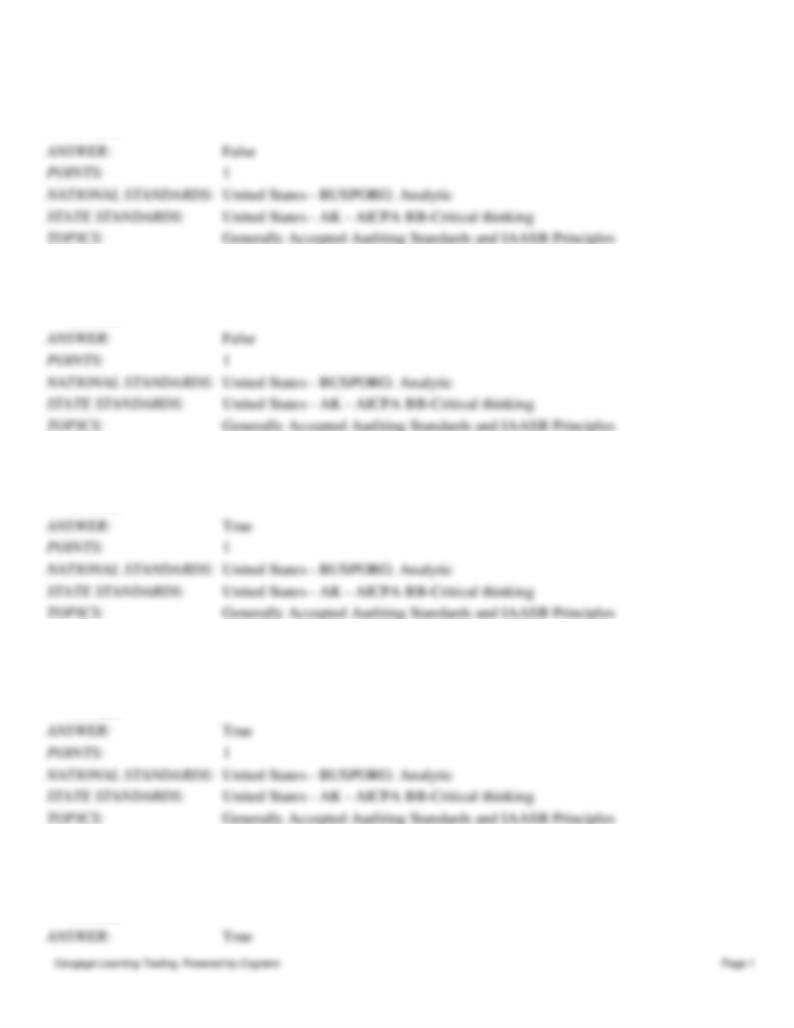
Chapter 5 - Professional Auditing Standards and the Audit Opinion Formulation Process
1. The auditing standards issued by the PCAOB are identical to the auditing standards issued by the AICPA.
a.
True
b.
False
2. The standards of the PCAOB consist of seven principles.
a.
True
b.
False
3. The PCAOB’s general standards provide guidance to audit firms in selecting and training their professionals.
a.
True
b.
False
4. The PCAOB’s second fieldwork standard requires auditors develop an understanding of the client’s controls
as an important prerequisite to developing specific audit tests.
a.
True
b.
False
5. The AICPA’s fundamental principles can be divided into four sections: purpose of the audit, responsibility of
the auditor, performance of the audit, and reporting of the results.
a.
True
b.
False
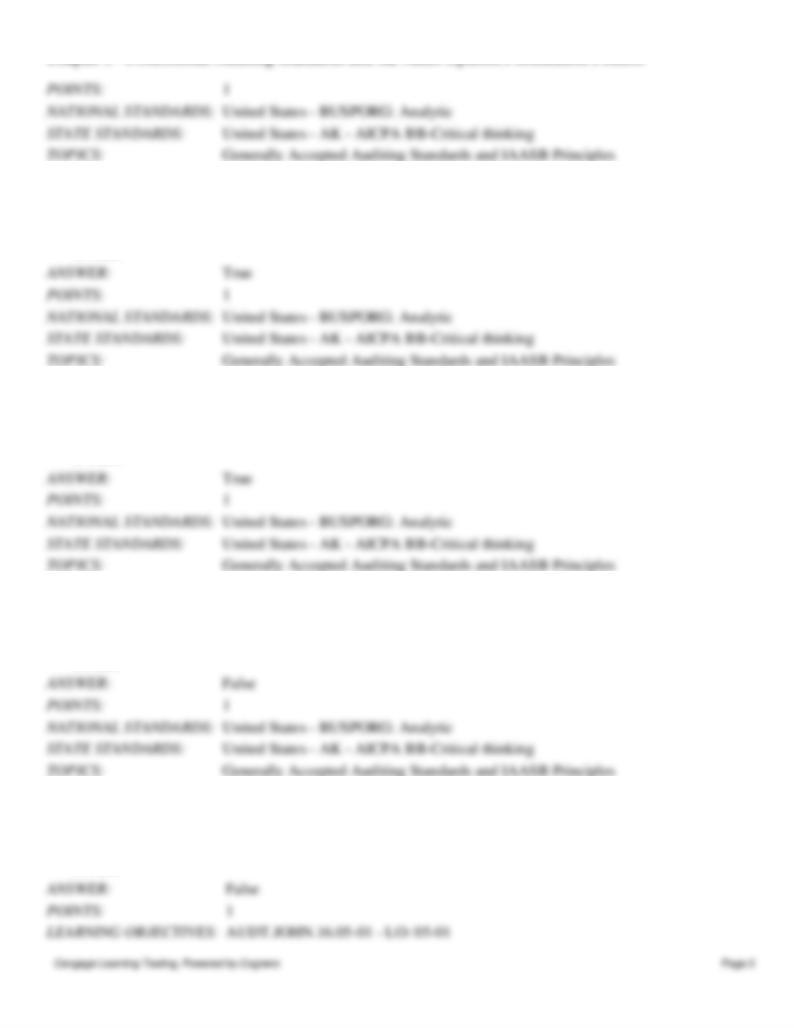
Chapter 5 - Professional Auditing Standards and the Audit Opinion Formulation Process
6. Auditors are responsible for having the appropriate competence and capabilities to perform the audit, should
comply with ethical requirements, and maintain professional skepticism throughout the audit.
a.
True
b.
False
7. An audit must be performed by persons who can make sound judgments relating to complex accounting
issues.
a.
True
b.
False
8. The auditor needs to obtain absolute assurance as to whether the financial statements are free from material
misstatement.
a.
True
b.
False
9. The Clarity Project is an initiative of the PCAOB to clarify the links between the standards of the PCAOB
and the AICPA.
a.
True
b.
False
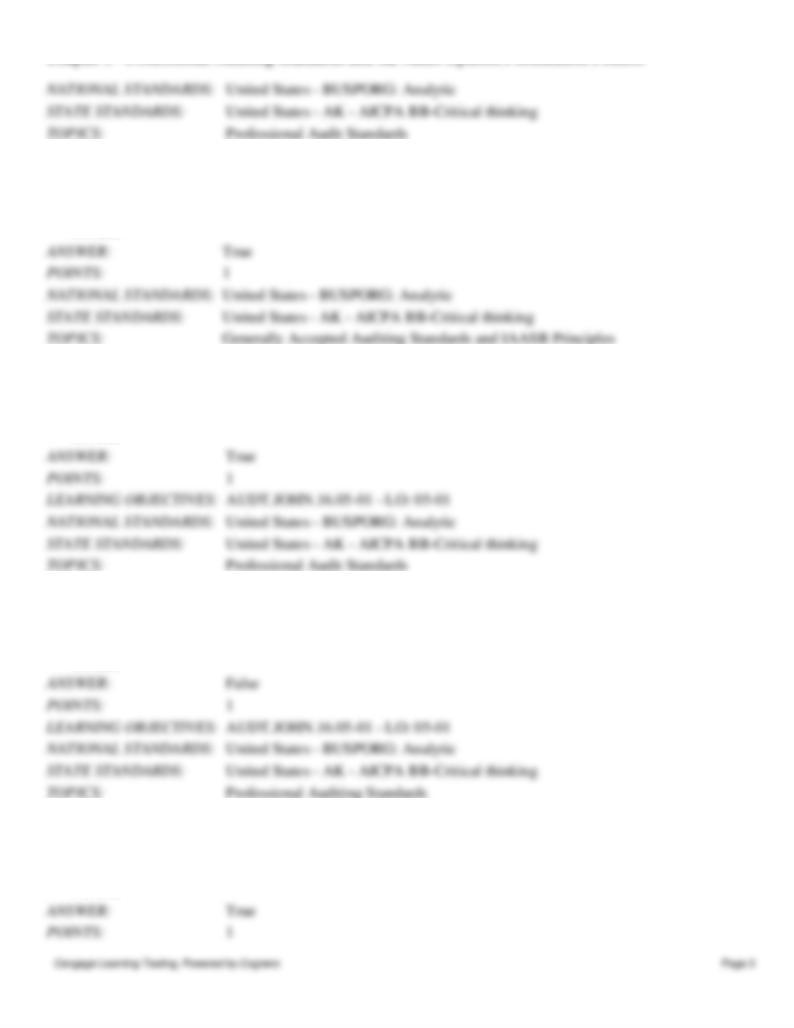
Chapter 5 - Professional Auditing Standards and the Audit Opinion Formulation Process
10. The ten standards of auditing, adopted by the PCAOB encompass three broad categories including: general
standards, fieldwork standards and reporting standards.
a.
True
b.
False
11. The common purpose of audit standards created by the various authorities is to provide reasonable
assurance that audits are conducted in a quality manner.
a.
True
b.
False
12. The AICPA principles governing an audit explicitly state that an audit has inherent limitations prohibiting
an auditor from obtaining reasonable assurance that the statements are free from misstatement.
a.
True
b.
False
13. If controls are effective, there is a higher likelihood that the financial statements are free of material
misstatement.
a.
True
b.
False
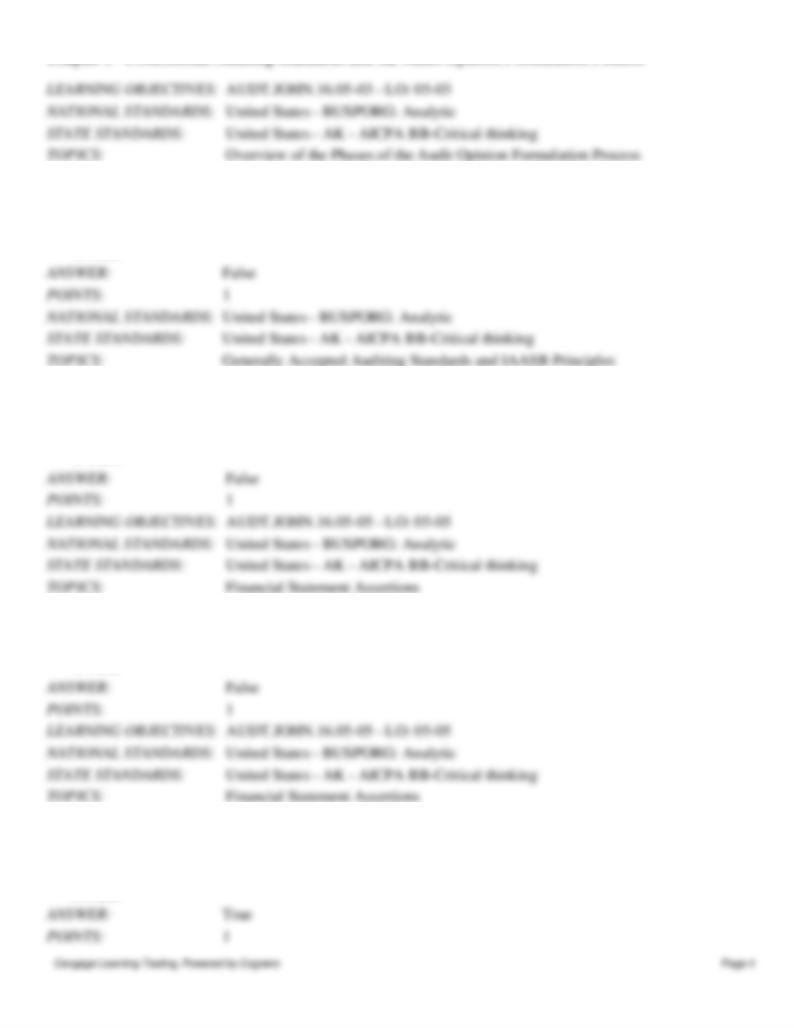
Chapter 5 - Professional Auditing Standards and the Audit Opinion Formulation Process
14. The reporting standards of the ten generally accepted audit standards of the PCAOB includes consistency,
disclosure, and due professional care.
a.
True
b.
False
15. Within each cycle, the audit is designed around the specific audit procedures required by the PCAOB
general standards.
a.
True
b.
False
16. Comparability is one of the five management assertions.
a.
True
b.
False
17. The PCAOB requires the audit be conducted with due professional care, which is a standard of care that
would be expected of a reasonably prudent auditor.
a.
True
b.
False
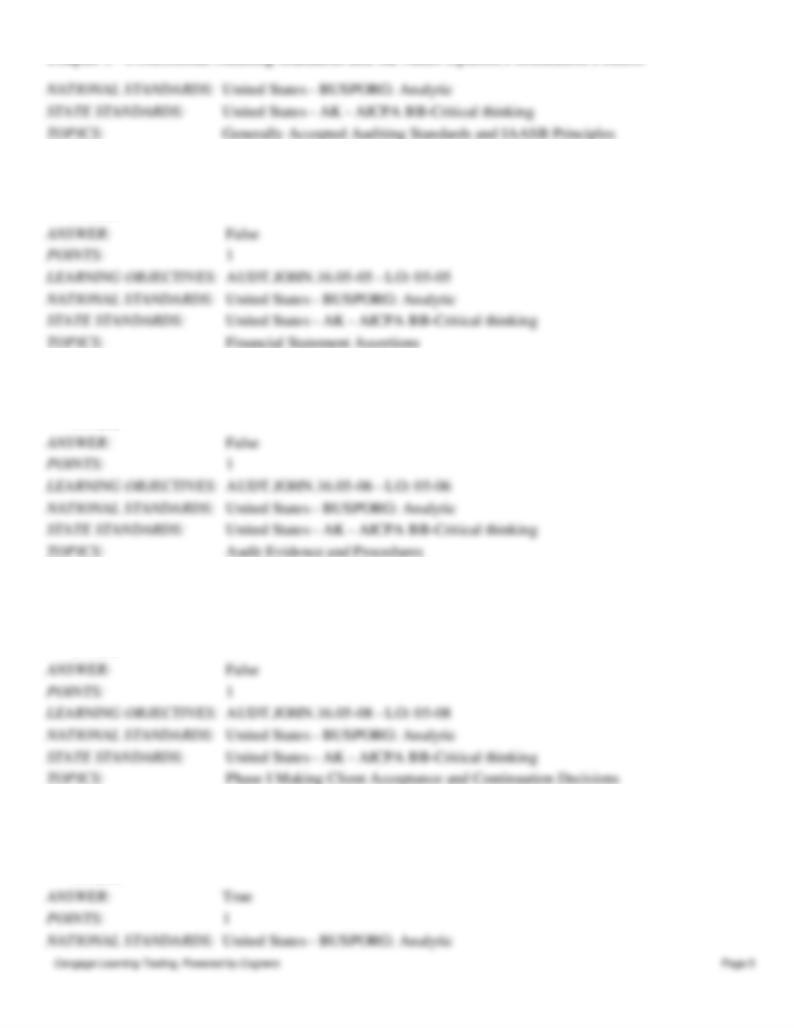
Chapter 5 - Professional Auditing Standards and the Audit Opinion Formulation Process
18. An auditor should give equal emphasis to all management assertions when testing accounts.
a.
True
b.
False
19. The nature of an audit procedure indicates when the procedure is performed during the audit.
a.
True
b.
False
20. An auditor typically indicates in the engagement letter that the audit will result in an unqualified report on
the financial statements.
a.
True
b.
False
21. Evidence is required to be sufficient and appropriate in order to provide a reasonable basis for audit
conclusions.
a.
True
b.
False
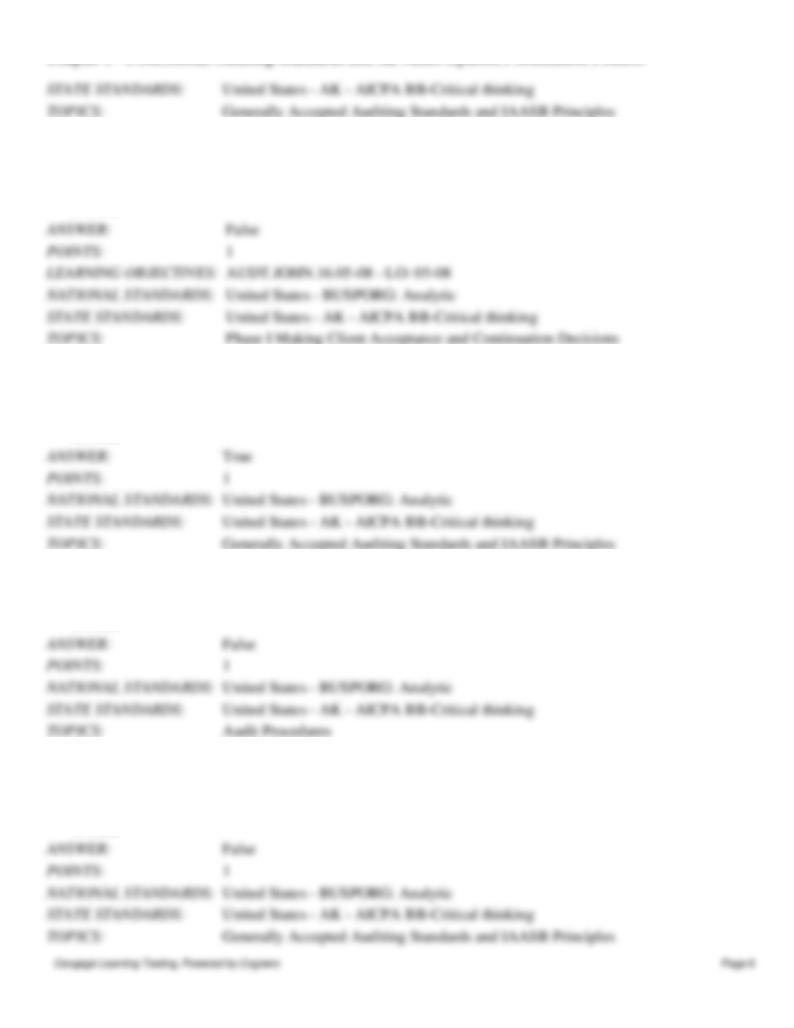
Chapter 5 - Professional Auditing Standards and the Audit Opinion Formulation Process
22. U.S. auditing standards recommend that a successor auditor on an initial audit obtain client permission to
communicate with the predecessor auditor.
a.
True
b.
False
23. Developing an understanding of the client's business and industry is essential to proficiency as discussed in
the PCAOB’s general standards.
a.
True
b.
False
24. Test of controls are a type of substantive procedure.
a.
True
b.
False
25. The Public Company Accounting Oversight Board (PCAOB) does not set specific standards for audits of
public companies.
a.
True
b.
False

Chapter 5 - Professional Auditing Standards and the Audit Opinion Formulation Process
26. Recalculation involves independently performing procedures or controls that were originally performed by
the client, such as reperforming a bank reconciliation.
a.
True
b.
False
27. Scanning is a type of analytical procedure which involves reviewing accounting data to identify significant
or unusual items, such as examining a credit balance in an account that typically has a debit balance.
a.
True
b.
False
28. Audit procedures can be classified as risk assessment procedures, test of controls or substantive tests.
a.
True
b.
False
29. Assertions about existence address whether assets and liabilities exist and assertions about occurrence
address whether recorded transactions, such as sales transactions, have occurred
a.
True
b.
False
30. The first stage in an audit is performing a risk assessment.
a.
True
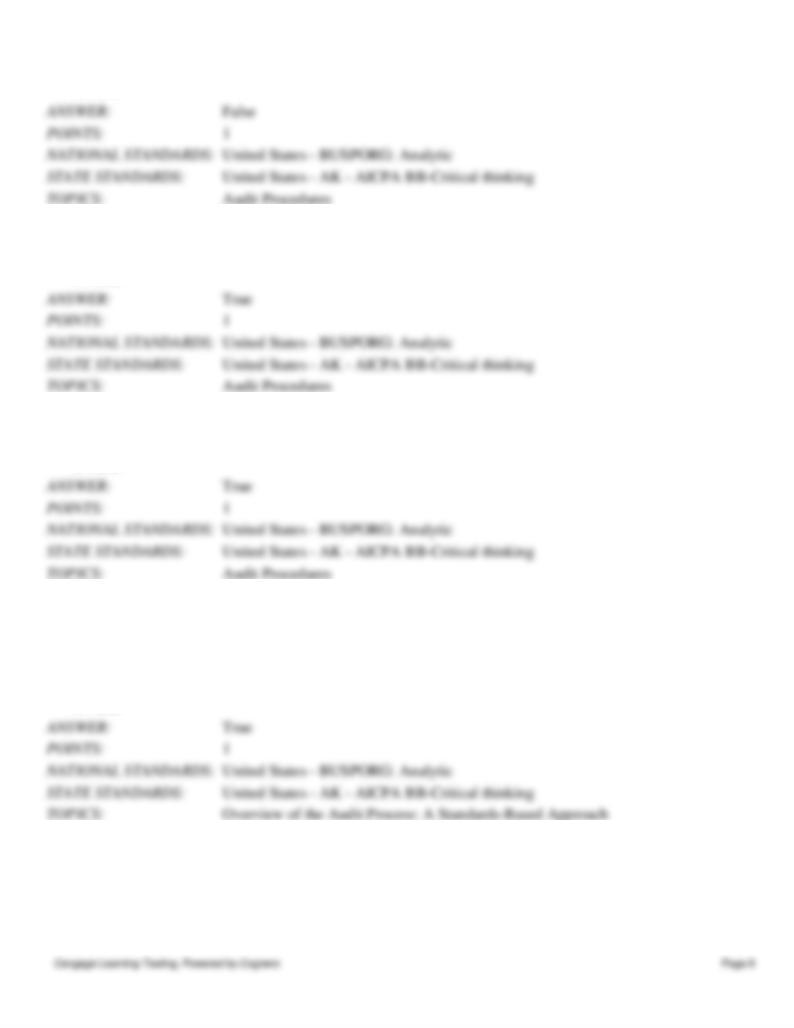
Chapter 5 - Professional Auditing Standards and the Audit Opinion Formulation Process
b.
False
31. Physically examining a client’s assets is an audit procedure.
a.
True
b.
False
32. Audit documentation is frequently called working papers.
a.
True
b.
False
33. Control risk refers to the risk that a misstatement could occur in an assertion about a class of transaction,
account balance, or disclosure and that could be material, either individually or when aggregated with other
misstatements, will not be prevented, or detected and corrected, on a timely basis by the entity’s internal
control.
a.
True
b.
False
34. Inherent risk refers to the susceptibility of an assertion about a class of transaction, account balance, or
disclosure to a misstatement that could be immaterial, either individually or when aggregated with other
misstatements, before consideration of any related controls.
a.
True
b.
False
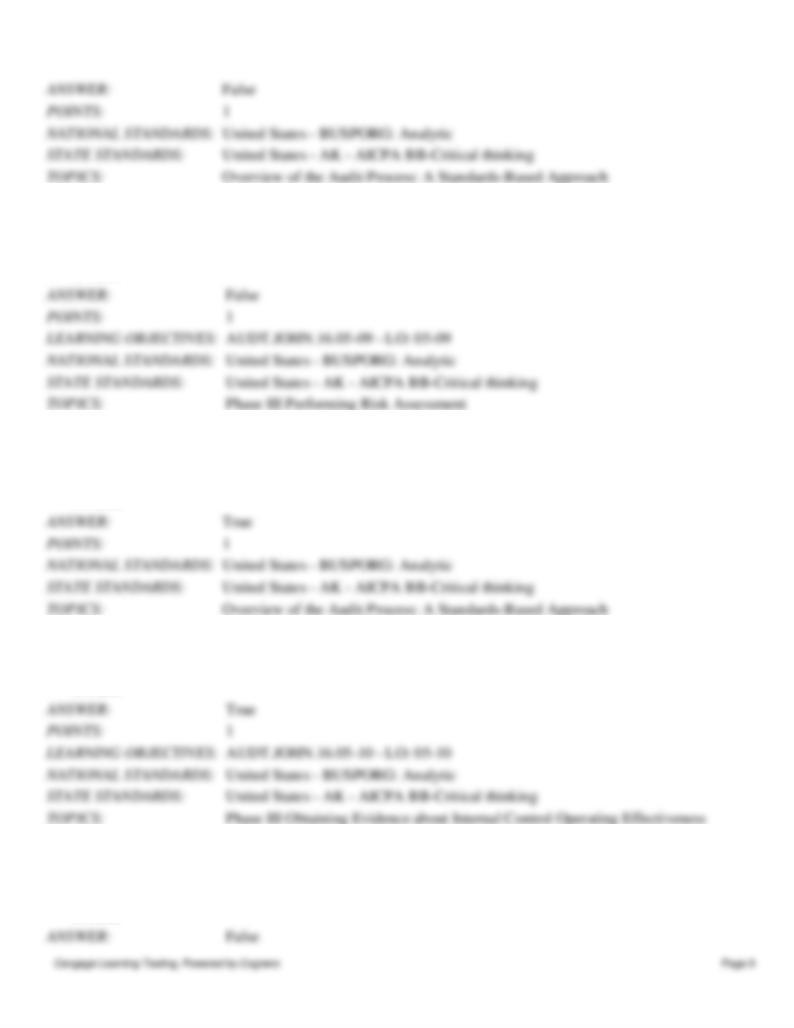
Chapter 5 - Professional Auditing Standards and the Audit Opinion Formulation Process
35. There is an inverse relationship between the assessment of risk of material misstatement in an account and
the amount of evidence required.
a.
True
b.
False
36. The purpose of the audit program is to list the audit procedures to be followed in gathering audit evidence
and to help those in charge of the audit to monitor the progress and supervise the work.
a.
True
b.
False
37. The effectiveness of entity-wide controls may reduce the extent of testing of transaction controls.
a.
True
b.
False
38. When assessing the effectiveness of controls for relevant assertions the auditor tests only transaction
controls.
a.
True
b.
False
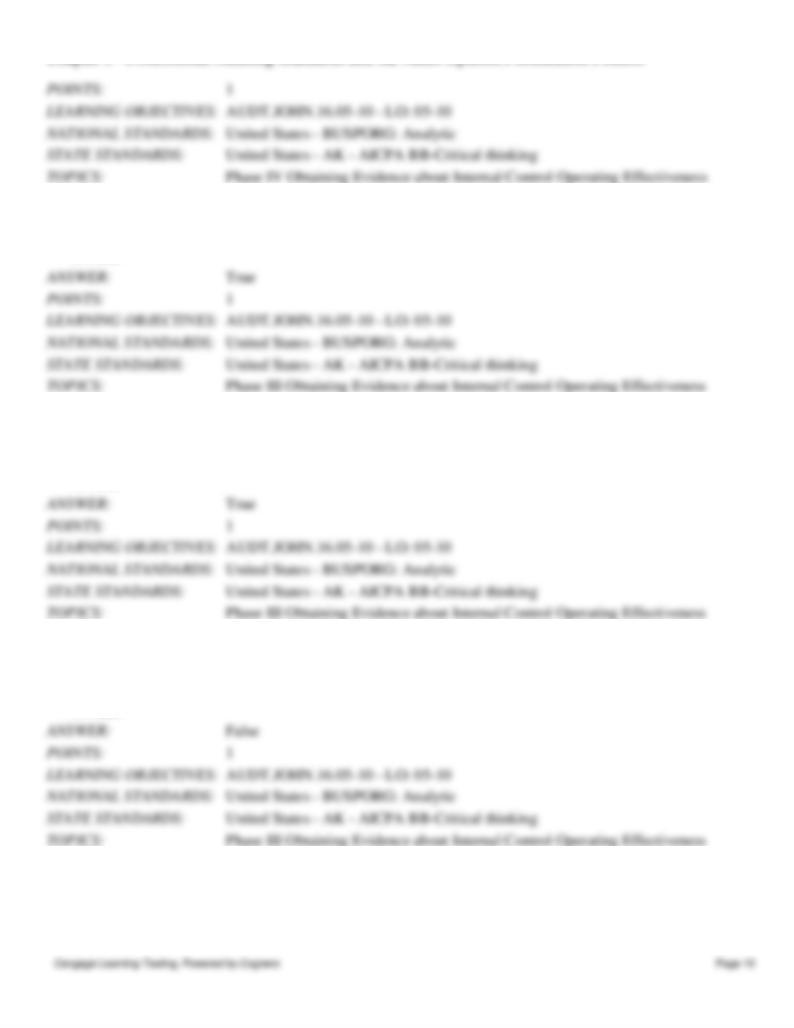
Chapter 5 - Professional Auditing Standards and the Audit Opinion Formulation Process
39. The auditor is not required to test every control related to relevant assertions in a significant account.
a.
True
b.
False
40. For an integrated audit, the auditor’s opinion about internal control effectiveness is based on control
effectiveness at year-end as opposed to throughout the year.
a.
True
b.
False
41. Research indicates that weaknesses in control components other than control activities do not cause fraud
and other misstatements in financial statements.
a.
True
b.
False
42. Assertions are relevant to the audit process because they are the representations of management embodied in
the financial statements.
a.
True
b.
False
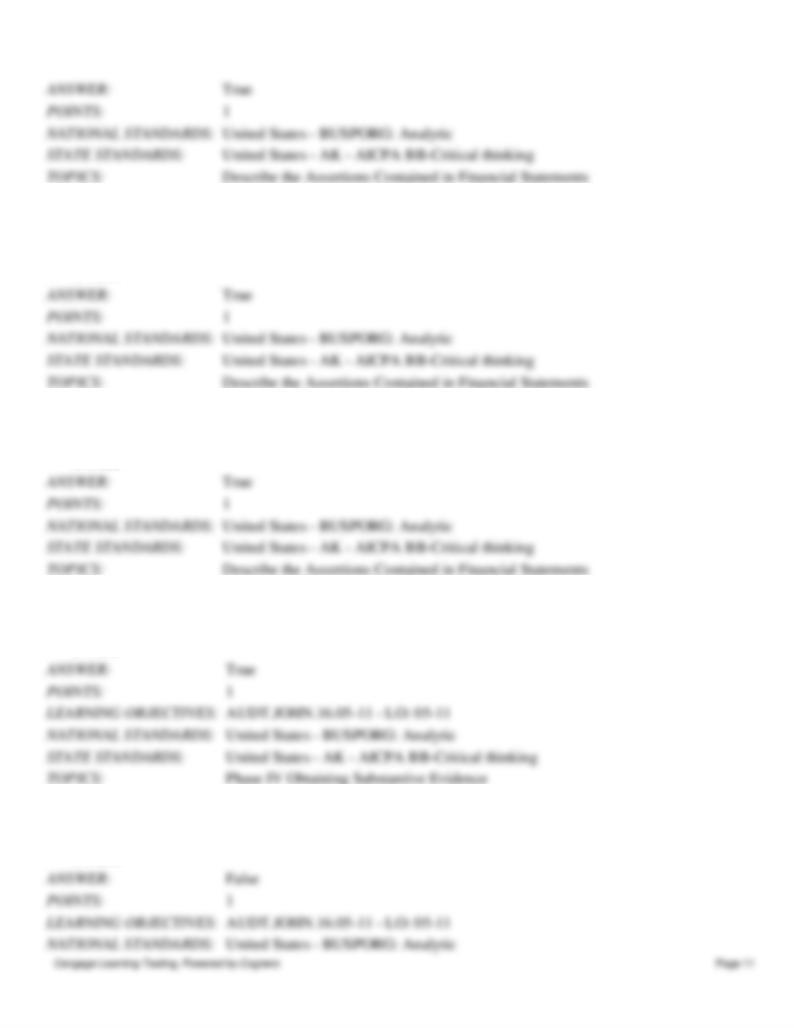
Chapter 5 - Professional Auditing Standards and the Audit Opinion Formulation Process
43. Presentation and disclosure assertions imply that all transactions and balances are properly presented,
disclosures represent what actually happened, and the footnote disclosures are appropriate and adequate.
a.
True
b.
False
44. The PCAOB does not currently have a mandate for convergence with other auditing standards.
a.
True
b.
False
45. Substantive analytical procedures are optional for significant tests and disclosures.
a.
True
b.
False
46. In performing substantive tests on account balances, the auditor performs tests for all five assertions.
a.
True
b.
False
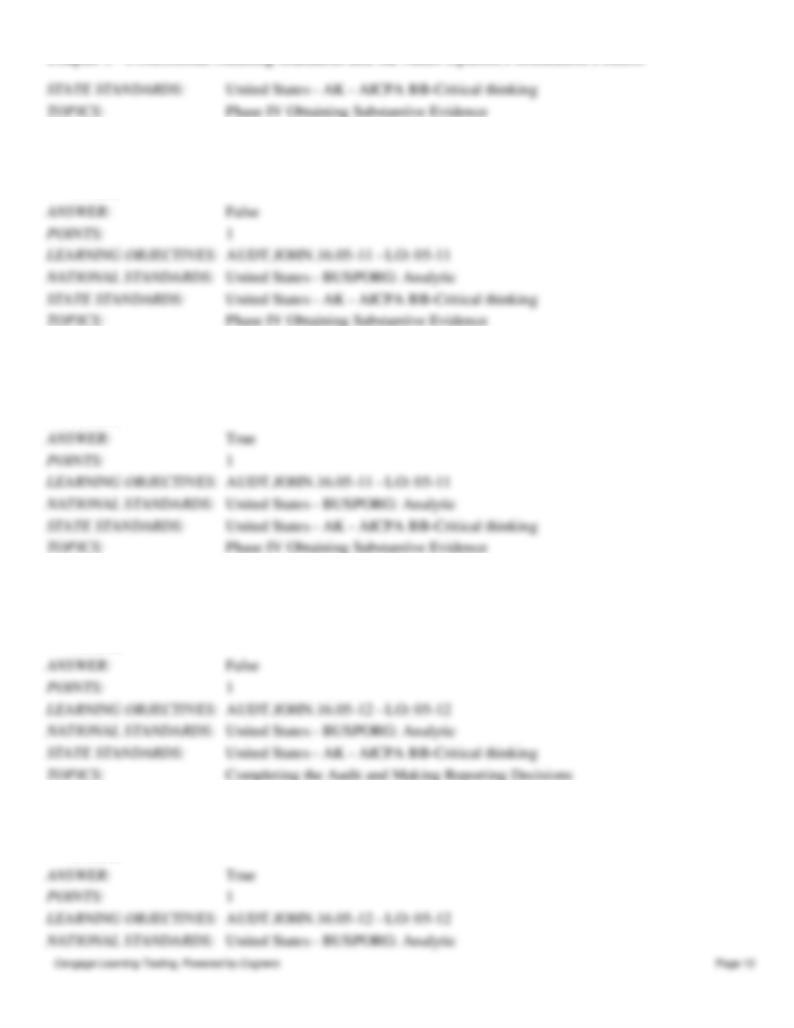
Chapter 5 - Professional Auditing Standards and the Audit Opinion Formulation Process
47. If the auditor assesses internal controls to be effective, less substantive testing is likely.
a.
True
b.
False
48. If the auditor’s assessment is that there is high risk due to the subjectivity of the accounting process,
substantive procedures should be more rigorous.
a.
True
b.
False
49. An Integrated Audit requires the issuance of separate reports for the opinions expressed on the financial
statements and on internal control..
a.
True
b.
False
50. In an integrated audit, the auditor issues an opinion on both the financial statements and internal control.
a.
True
b.
False
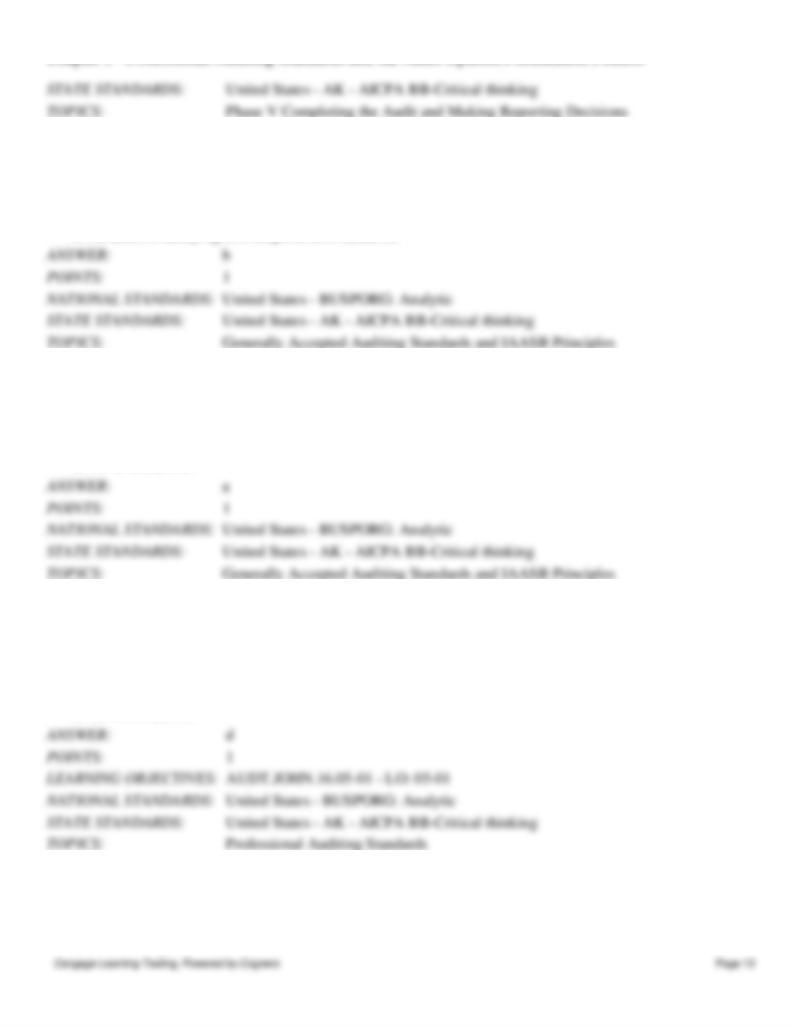
Chapter 5 - Professional Auditing Standards and the Audit Opinion Formulation Process
51. The first general standard of the PCAOB requires that an audit be performed by which type of person?
a.
An auditor with seasoned judgment in varying degrees of supervision and review.
b.
An auditor with appropriate technical training and proficiency.
c.
An auditor with adequate knowledge of the standards of field work and reporting.
d.
An auditor satisfying the independence standards.
52. Which auditing standards apply to private companies?
a.
The AICPA Standards.
b.
The IASSB Standards.
c.
The Standards of the PCAOB.
d.
All of the above.
53. The AICPA Principles Governing an Audit include which of the following categories that guide the conduct
of an audit?
a.
Purpose of an audit and premise upon which an audit is conducted.
b.
Responsibilities.
c.
Performance.
d.
All of the above.
54. What is the scope of applicability of the auditing standards of the AICPA?
a.
Nonpublic companies traded in non-U.S. markets.
b.
Nonpublic companies in the U.S.
c.
Public companies traded in non-U.S. markets.
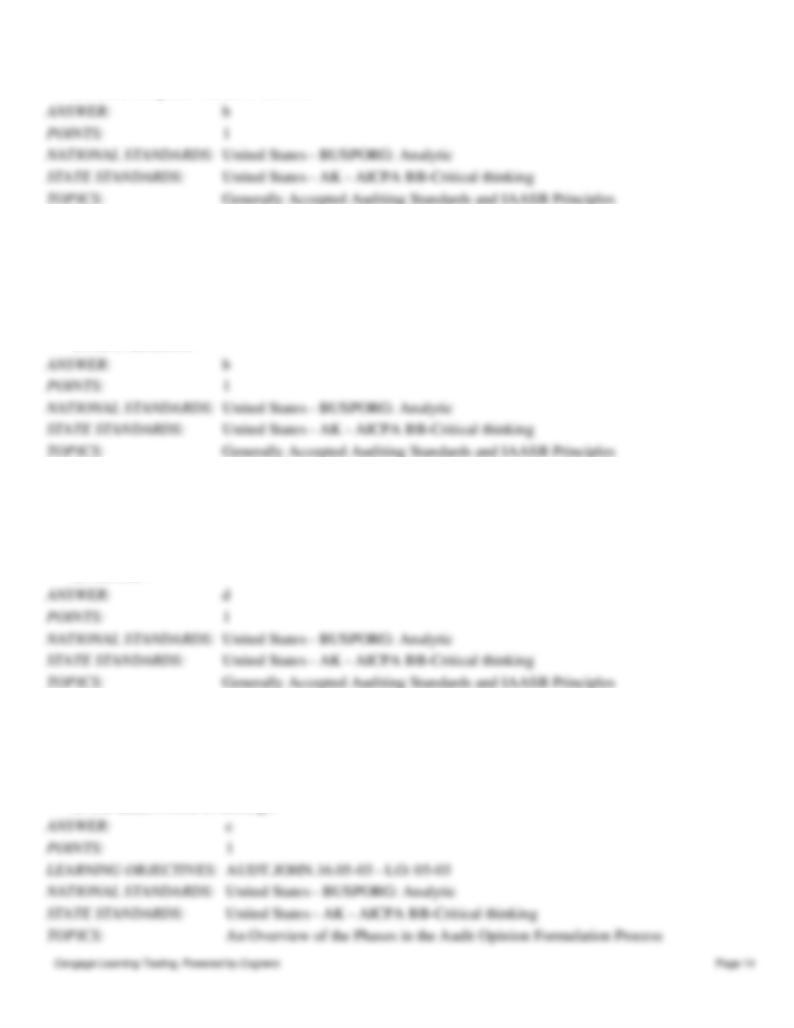
Chapter 5 - Professional Auditing Standards and the Audit Opinion Formulation Process
d.
Public companies traded in the U.S.
55. To satisfy the fieldwork standards, what must an auditor do?
a.
Act with due care.
b.
Gather sufficient appropriate evidence.
c.
Be independent in mental attitude.
d.
Have adequate knowledge about the client’s industry.
e.
All of the above.
56. Which one of the following organizations provides auditing standards for public companies?
a.
GAO.
b.
AICPA.
c.
GAAP.
d.
PCAOB.
57. Which one of the following has the most affect on the reliability of financial statements?
a.
The size of the client
b.
The industry of the client
c.
The client’s internal control structure.
d.
The client’s trend of earnings.
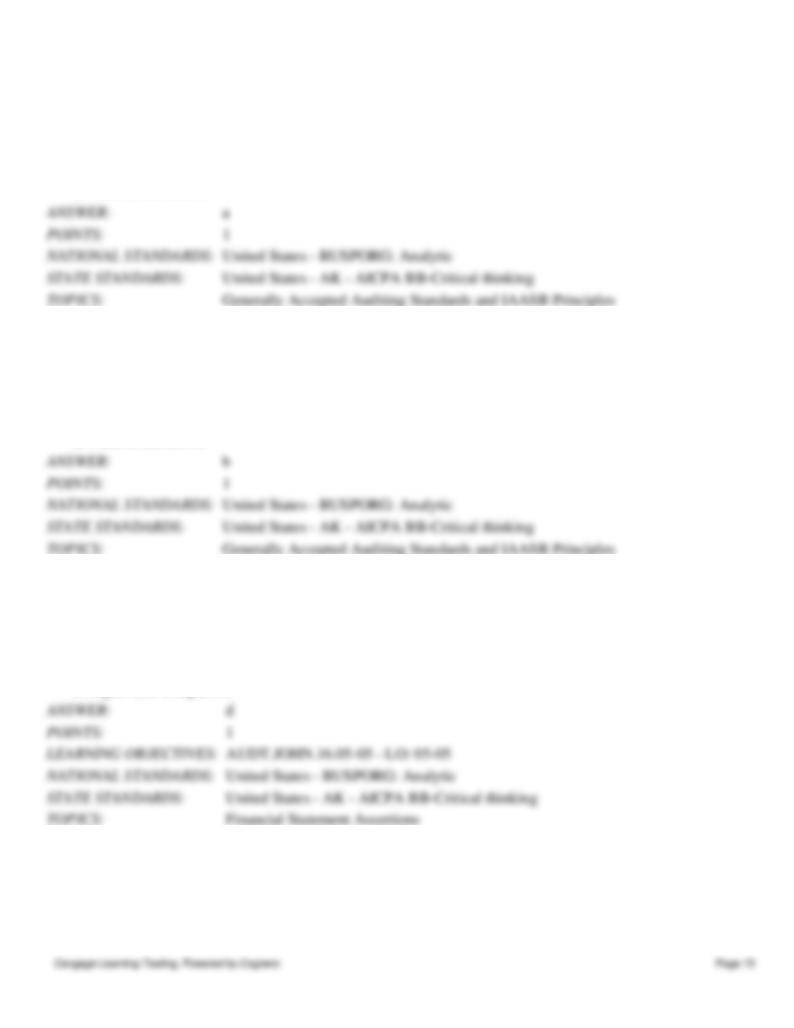
Chapter 5 - Professional Auditing Standards and the Audit Opinion Formulation Process
58. The standards of competence, independence, and due professional care are covered by which section of the
generally accepted auditing standards?
a.
General standards.
b.
Standards of fieldwork.
c.
Reporting standards.
d.
None of the above.
59. What are the PCAOB standards that present guidance in testing assertions and planning for the audit are
known as?
a.
General standards.
b.
Fieldwork standards.
c.
Reporting standards.
d.
None of the above.
60. Which of the following is the primary assertion related to testing inventory on hand to see if it includes
consignment goods ?
a.
Existence
b.
Completeness
c.
Valuation
d.
Rights and Obligations
61. Which assertion is most closely related to the determination of the adequacy of the allowance for doubtful
accounts?
a.
Existence
b.
Valuation
c.
Rights and Obligations
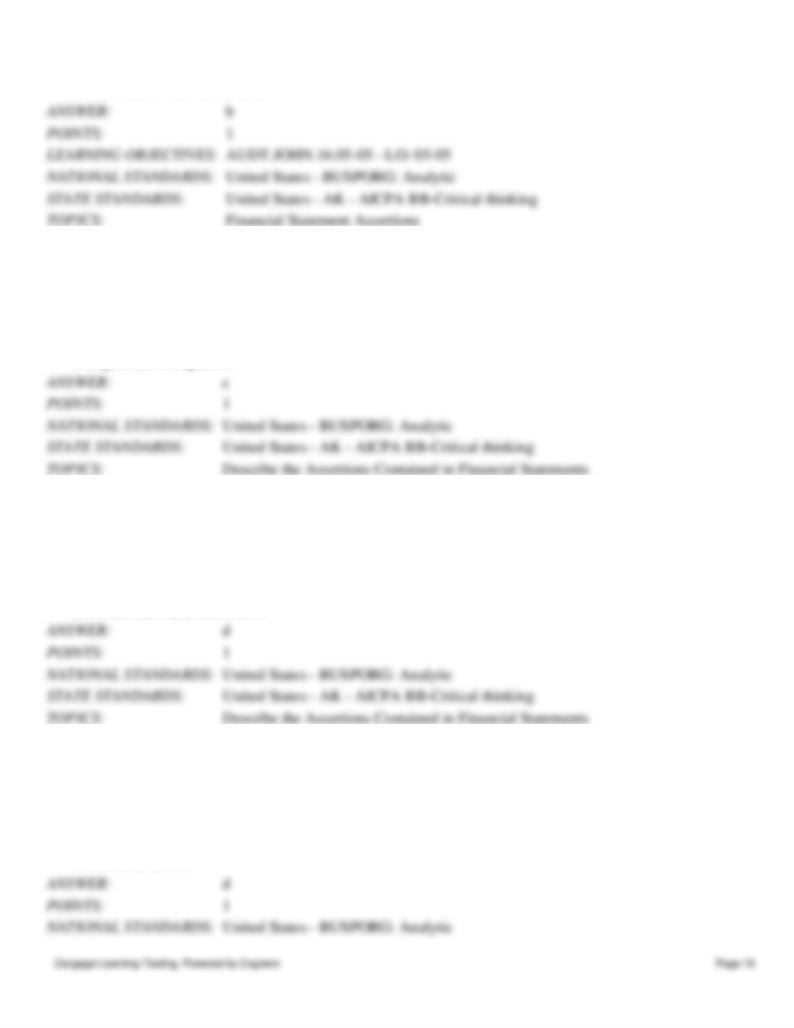
Chapter 5 - Professional Auditing Standards and the Audit Opinion Formulation Process
d.
Presentation and Disclosure
62. Which assertion addresses whether all transactions and accounts that should be included in the financial
statements are included?
a.
Existence.
b.
Valuation.
c.
Completeness.
d.
Rights and Obligations
63. Which assertion addresses whether the financial statements items are properly classified in the financial
statements?
a.
Completeness.
b.
Existence.
c.
Valuation.
d.
Presentation and Disclosure.
64. Which of the following groups are committed to the convergence of the auditing standards?
a.
IAASB.
b.
PCAOB.
c.
AICPA.
d.
Both A and C.
e.
All of the above.
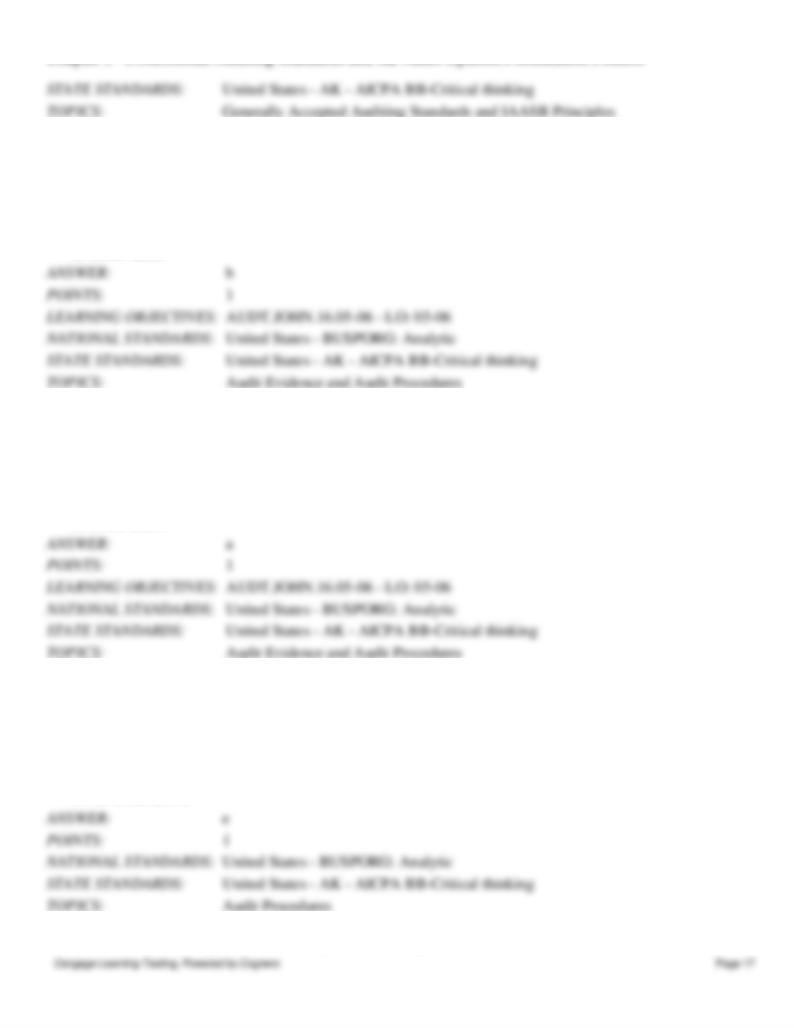
Chapter 5 - Professional Auditing Standards and the Audit Opinion Formulation Process
65. Which of the following is a procedure that requests a direct written response to the auditor form a third
party?
a.
Inquiry
b.
Confirmation
c.
Inspection
d.
Observation
66. Which of the following is a procedure which analyzes plausible relationships among financial and
nonfinancial data?
a.
Analytical procedures.
b.
Scanning.
c.
Reviewing.
d.
Observation.
67. What does the quality of the evidence an auditor collects depend upon?
a.
The nature of the procedures.
b.
The extent of the procedures.
c.
The timing of the procedures.
d.
Both A and C.
e.
All of the above.
68. Which of the following terms describes procedures designed to detect material misstatements in accounts ?
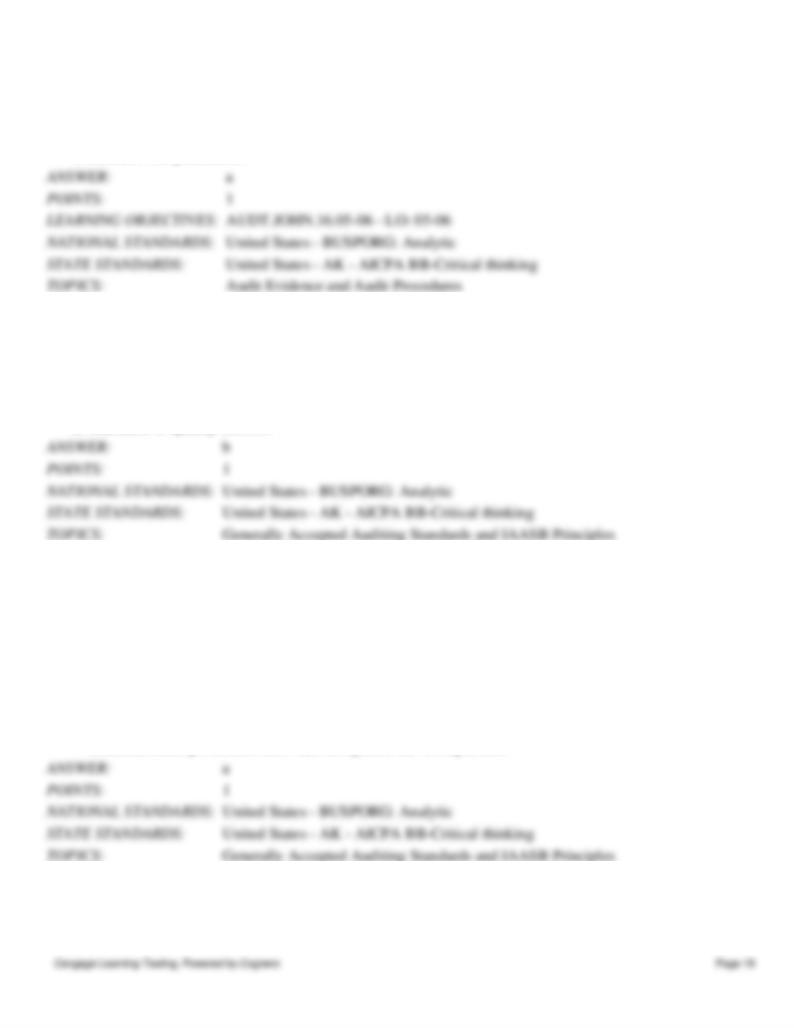
Chapter 5 - Professional Auditing Standards and the Audit Opinion Formulation Process
a.
Substantive procedures.
b.
Control Tests
c.
Risk assessment procedures
d.
Business risk procedures.
69. The proper supervision of audit assistants is a requirement found in which section of the Generally Accepted
Auditing Standards?
a.
General Standards.
b.
Standards of Fieldwork.
c.
Standards of Reporting.
d.
Standards of Quality Control.
70. Which one of the following is a requirement pf the reporting standards included in the generally accepted
auditing standards?
a.
The auditor will state explicitly whether the financial statements are fairly presented in accordance
with the applicable financial reporting framework.
b.
The auditor will identify in the auditor’s report, those circumstances in which auditing principles
have not been consistently observed in the current period in comparison to the preceding period.
c.
The auditor will review adjusting journal entries for accuracy, and if the auditor concludes those
entries are not reasonable accurate, the auditor must so state in the auditor’s report.
d.
The auditor will express an unqualified opinion on the financial statements, or will conduct
additional audit procedures until such an opinion can be expressed.
71. Which of the following statements about the auditing standards issued by the AICPA is true?
a.
The auditing standards issued by the AICPA are no longer recognized by the PCAOB.
b.
The auditing standards issued by the AICPA are no longer recognized by the profession because the
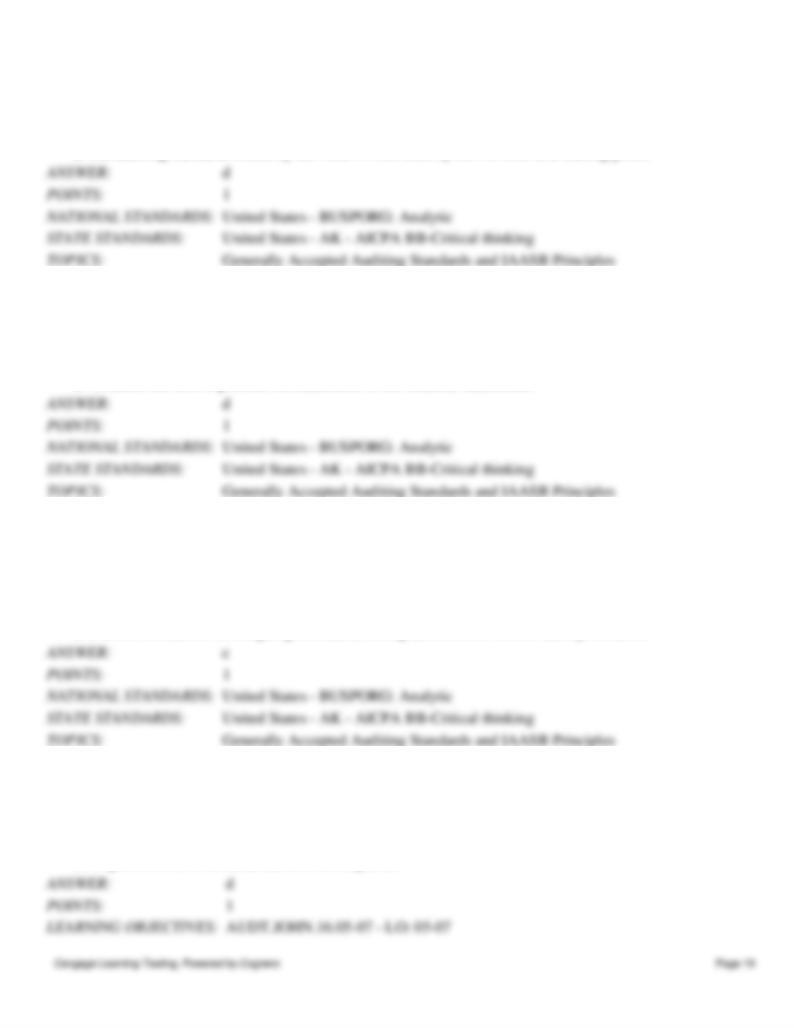
Chapter 5 - Professional Auditing Standards and the Audit Opinion Formulation Process
AICPA voted itself out of existence.
c.
The auditing standards issued by the AICPA continue to be issued by that organization for audits of
public companies.
d.
The auditing standards issued by the AICPA were used by the PCAOB as a starting point.
72. Which of the following is a reason why an auditor needs an understanding of internal controls?
a.
To provide individual comments on internal control non-compliance.
b.
To become comfortable that the client will pay its audit bills.
c.
To assess materiality.
d.
To assess the risk of possible misstatements in the financial statements.
73. Which of the following is not a reason why an auditor obtains an understanding of internal controls?
a.
Understanding the entity's internal control is a requirement of GAAS.
b.
The auditor must use the information to assess the risk of material misstatements arising from the
lack of internal control.
c.
It is the primary basis for the audit report.
d.
It assists the auditor in designing the nature, timing and extent of further audit procedures.
74. Which type of audit documentation is required by PCAOB standards?
a.
Flowcharts
b.
Narratives
c.
Questionnaires
d.
A specific form of documentation is not required.
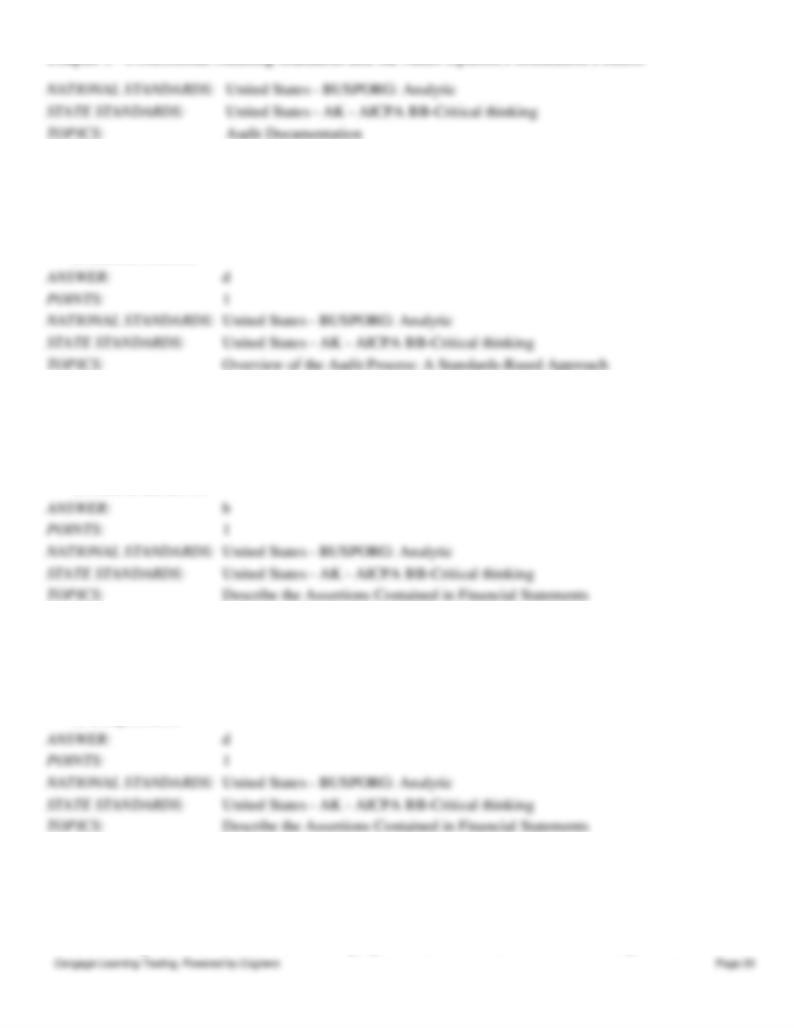
Chapter 5 - Professional Auditing Standards and the Audit Opinion Formulation Process
75. Which of the following is not a typical accounting cycle?
a.
Revenue.
b.
Inventory.
c.
Cash.
d.
Internal Controls.
76. Which of the following statements about assertions is true?
a.
All assertions are equally important for all accounts.
b.
The importance of an assertion depends upon the account.
c.
Assertions are not related to accounts.
d.
None of the above.
77. Which of the following assertions would the auditor usually consider most relevant for accounts payable?
a.
Existence.
b.
Valuation.
c.
Disclosure.
d.
Completeness.
78. Which of the following is a use of audit documentation?
a.
Assisting the engagement team in planning and performing the audit.
b.
Assisting members of the engagement team responsible for supervising and reviewing the audit
work.
c.
Retaining a record of matters of continuing significance to future audits of the same organization.
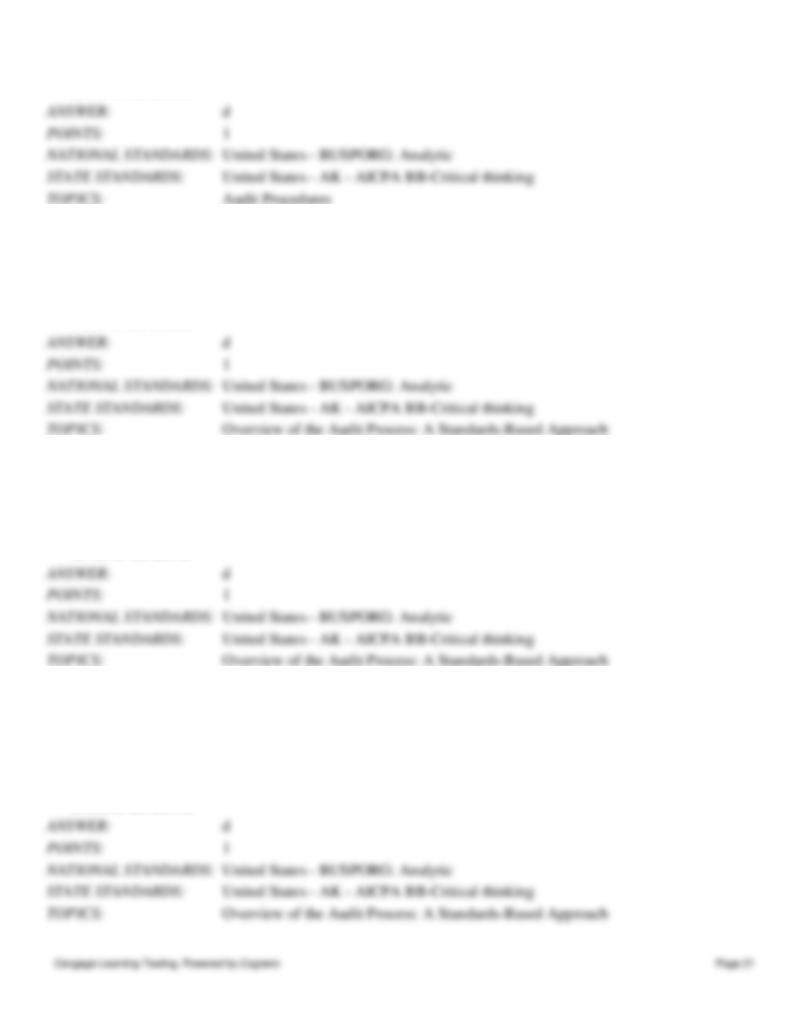
Chapter 5 - Professional Auditing Standards and the Audit Opinion Formulation Process
d.
All of the above.
79. Which of the following factors influence the risk of material misstatement?
a.
The business risks.
b.
Management incentives.
c.
IT risks.
d.
All of the above.
80. What does business risk include?
a.
Economic factors.
b.
Competitive factors.
c.
Regulatory risk.
d.
All of the above.
81. At what level does the auditor assess the risk of material misstatement?
a.
The financial statement level.
b.
The company level.
c.
The assertion level.
d.
Both A and C.
e.
All of the above.
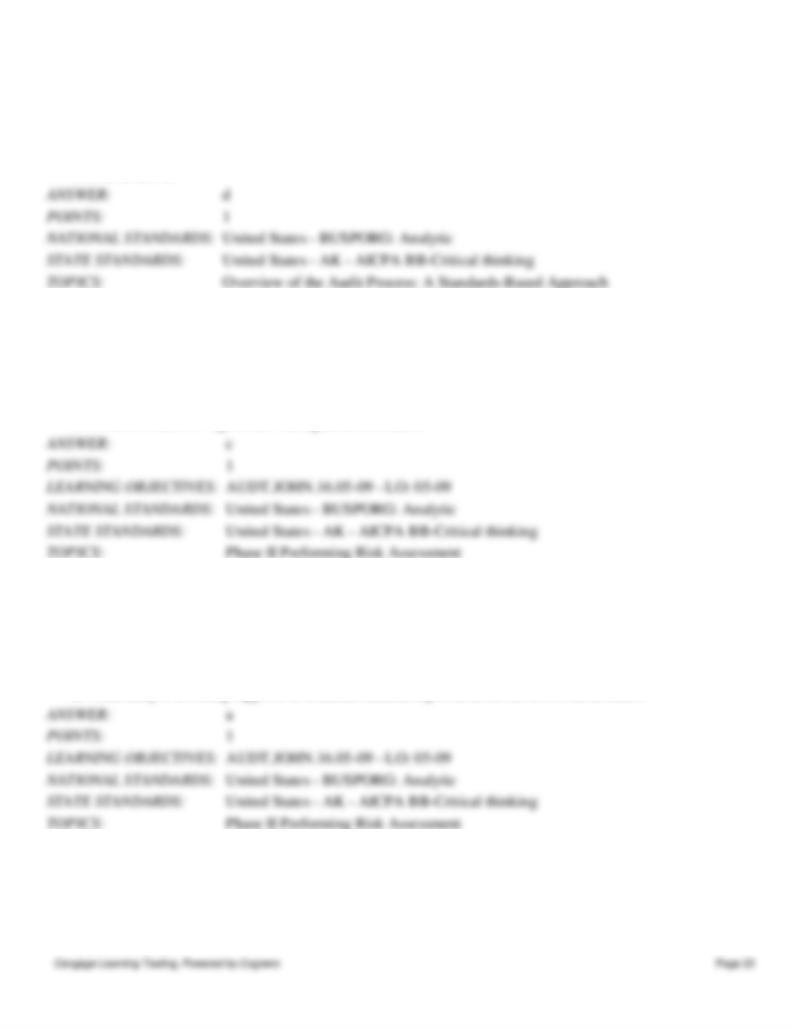
Chapter 5 - Professional Auditing Standards and the Audit Opinion Formulation Process
82. What does the effectiveness of internal controls influence?
a.
Inherent risk.
b.
Control risk.
c.
Risk of material misstatement.
d.
Both B and C.
83. Which of the following is not a control that the PCAOB has identified that auditors should consider in
evaluating whether or not an organization has sufficiently addressed fraud risk?
a.
Controls over significant, unusual transaction.
b.
Controls over related-party transactions.
c.
Controls related to marketable securities.
d.
Controls related to significant management estimates.
84. Which statement is true concerning materiality?
a.
Misstatements are material if they could reasonably be expected to influence the decisions of users of
the financial statements.
b.
Materiality guidelines are specifically prescribed by the PCAOB.
c.
Materiality is not a useful concept in assessing internal control effectiveness.
d.
Materiality is a concept applied to financial statement presentation but not to disclosures.
85. Which document is used by auditors to formally accept a new client?
a.
Management representation letter.
b.
Audit Report.
c.
Engagement Letter.
d.
Audit Contract.
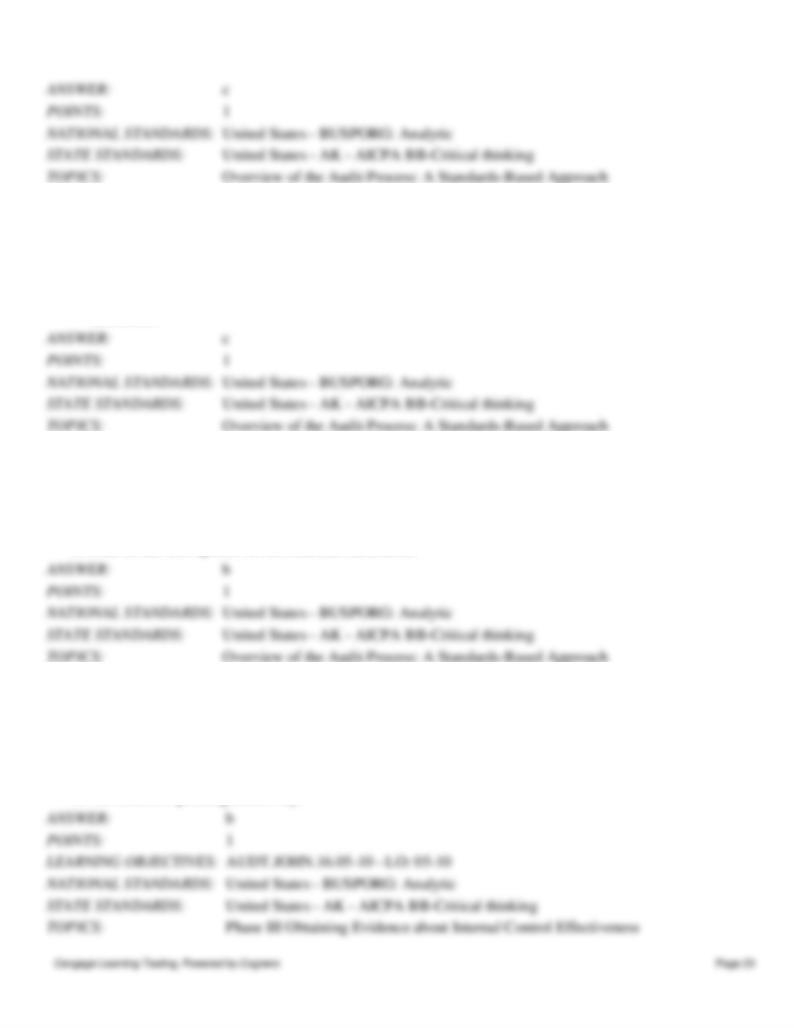
Chapter 5 - Professional Auditing Standards and the Audit Opinion Formulation Process
86. Which of the following items is not included in the engagement letter?
a.
The responsibilities of the auditor.
b.
The responsibilities of management.
c.
The objective of the financial statements.
d.
Identification of the applicable financial reporting framework for the preparation of the financial
statements.
87. With a substantive audit strategy, what is an auditor likely to do?
a.
Extensively tests internal controls.
b.
Limit the testing of internal controls.
c.
Not assess control risks.
d.
Issue an adverse opinion on the financial statements.
88. Which of the following is not a question an auditor considers in deciding whether to pursue a lower control
risk approach prior to substantive testing?
a.
Is the design of the control effective?
b.
Does the control promote operational efficiency?
c.
Is it cost effective to test controls?
d.
Are controls operating effectively?

Chapter 5 - Professional Auditing Standards and the Audit Opinion Formulation Process
89. Which of the following would not affect an auditor's judgment concerning internal controls?
a.
The assertion being tested.
b.
The design of the control.
c.
The operation of the control.
d.
The level of inherent risk.
90. With a dual purpose test, what is an auditor likely to do?
a.
Perform a substantive procedure concurrently with a test of a control.
b.
Perform a substantive procedure concurrently with a risk assessment test.
c.
Perform a risk assessment test concurrently with a test of a control.
d.
None of the above.
91. Which statement is correct?
a.
Assertions affected by highly objective estimates usually require direct tests of balances.
b.
The materiality of the account totally dictates the substantive procedures to be performed.
c.
The evidence the auditor obtains from risk assessment procedures does not influence the substantive
procedures to be performed.
d.
The extent and results of control tests performed by the auditor will influence the substantive
procedures to be performed.
92. Which of the following factors affect the substantive procedures performed in an audit?
a.
The subjectivity of accounting process.
b.
Size of the account.
c.
Effectiveness of the relevant controls.
d.
All of the above affect the substantive procedure that are performed.
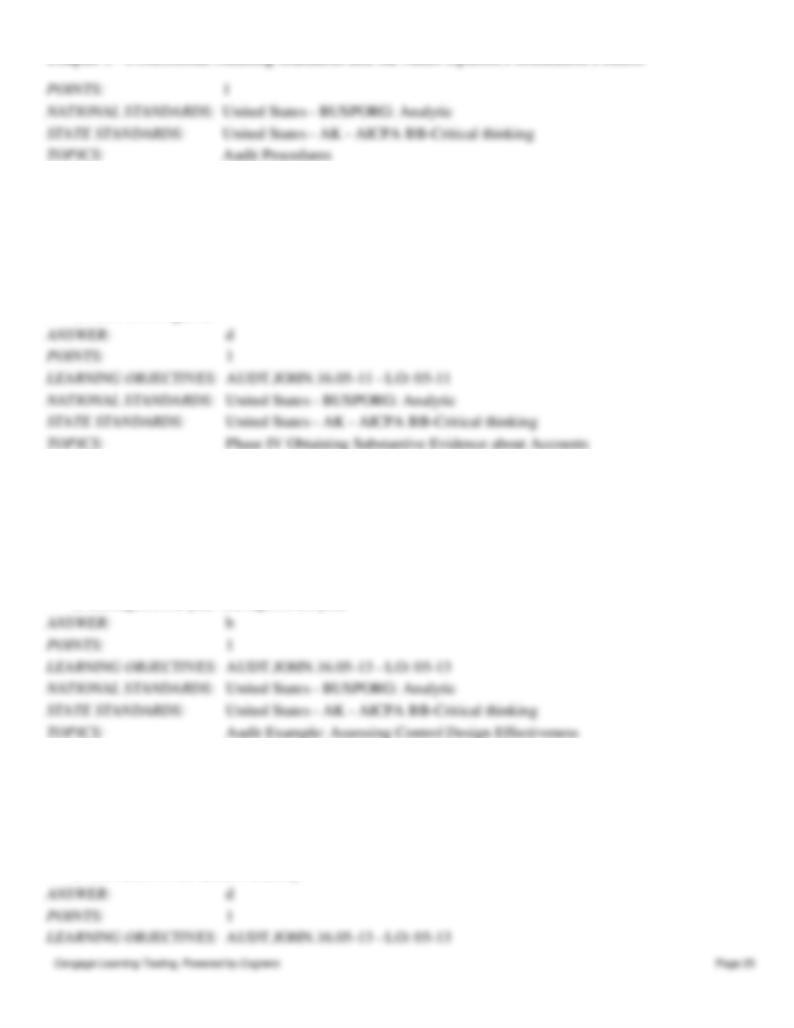
Chapter 5 - Professional Auditing Standards and the Audit Opinion Formulation Process
93. If the auditor’s assessment of the materiality of the account balance is high, what would be the respective
effect on the extent of substantive testing and the nature of procedures performed?
Extent of Tests Nature of Procedures
a.
Less More rigorous
b.
Less Less rigorous.
c.
More Less rigorous
d.
More More rigorous
94. An auditor gathers evidence on internal controls for which respective time periods for the purposes of
expressing an opinion on control effectiveness and for testing controls in the financial statement period?
Control Effectiveness Financial Statement
a.
As of year end As of year end
b.
As of year end Throughout the year
c.
Throughout the year As of year end
d.
Throughout the year Throughout the year
95. Which of the following would not be a factor in whether a control weakness would be considered to be a
material weakness as opposed to a significant deficiency?
a.
The materiality of the related balance.
b.
The volume of transactions affected.
c.
The subjectivity of the account balance.
d.
The nature of the client’s industry.
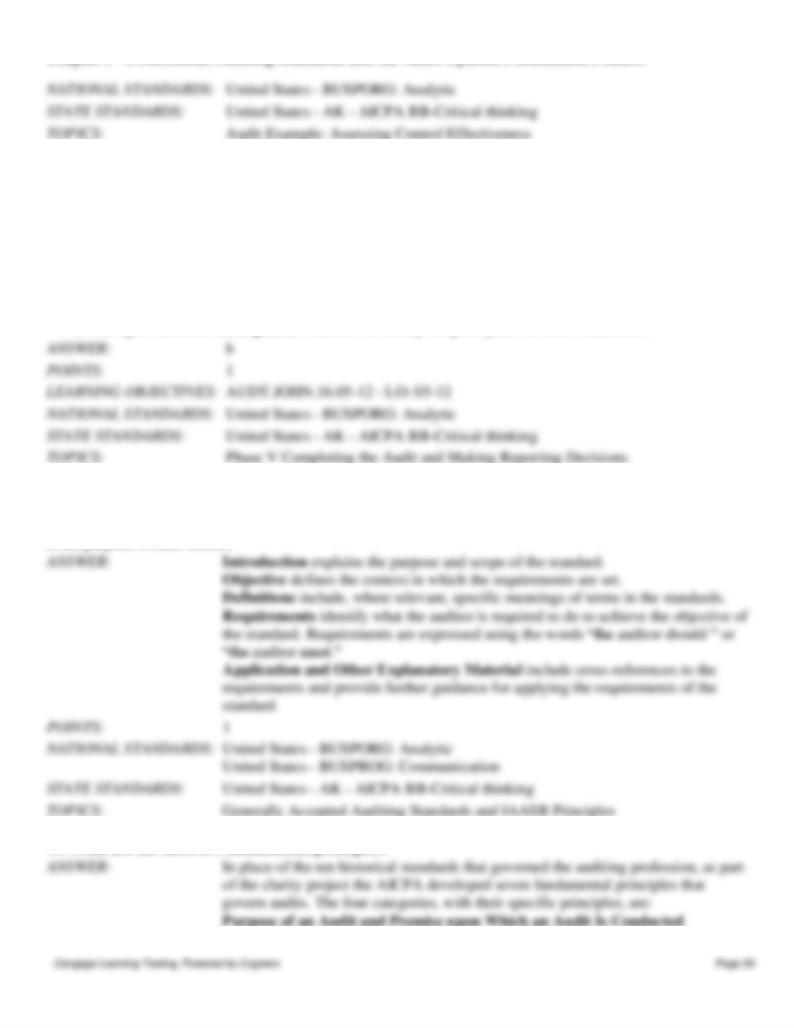
Chapter 5 - Professional Auditing Standards and the Audit Opinion Formulation Process
96. Which of the following statements is correct concerning the auditor’s opinion on internal control
effectiveness?
a.
The report describes any material weaknesses and discusses actions taken by management to
remediate the problems.
b.
The report does not discuss whether the control weaknesses were first identified by management or
the auditor.
c.
The report does not recognize the integrated nature of the audit and the affect of the material
weakness on the planning of the financial statement audit.
d.
The report identifies management’s actions to remedy the prior year’s control weaknesses.
97. The auditing standards
Under the clarified auditing standards, what is the structure of each auditing standard issued by the ASB? What
is the purpose of each section?
98. What are the AICPA’s fundamental principles?
1. The purpose of an audit is to enhance the degree of confidence that users can
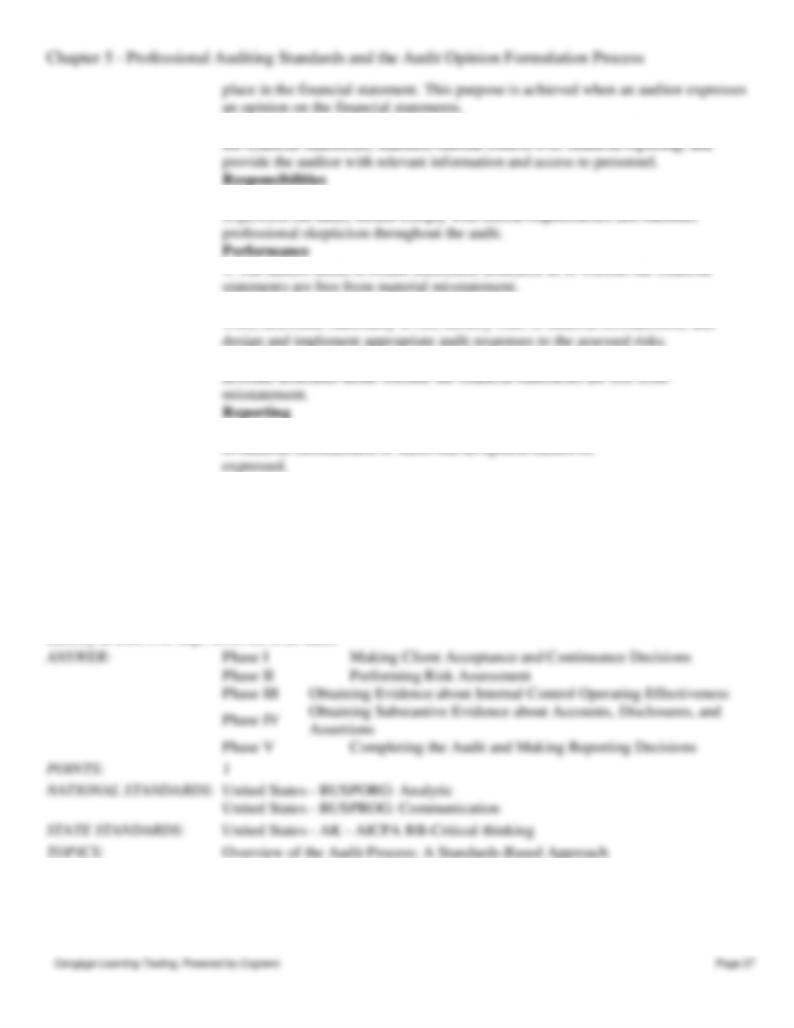
2. An audit is based on the premise that management has responsibility to prepare
3. Auditors are responsible for having the appropriate competence and capabilities
5. Obtaining reasonable assurance requires the auditor to plan and supervise the
6. An audit has inherent limitations such that the auditor is not able to obtain
7. The auditor expresses an opinion as to whether the financial statements are free
POINTS:
1
NATIONAL STANDARDS:
United States - BUSPORG: Analytic
United States - BUSPROG: Communication
STATE STANDARDS:
United States - AK - AICPA BB-Critical thinking
TOPICS:
Generally Accepted Auditing Standards and IAASB Principles
99. Audit phases
Identify at least five steps involved in an audit.
100. PCAOB Assertions
Discuss the five management financial statement assertions identified in the PCAOB Standards. Provide
examples.
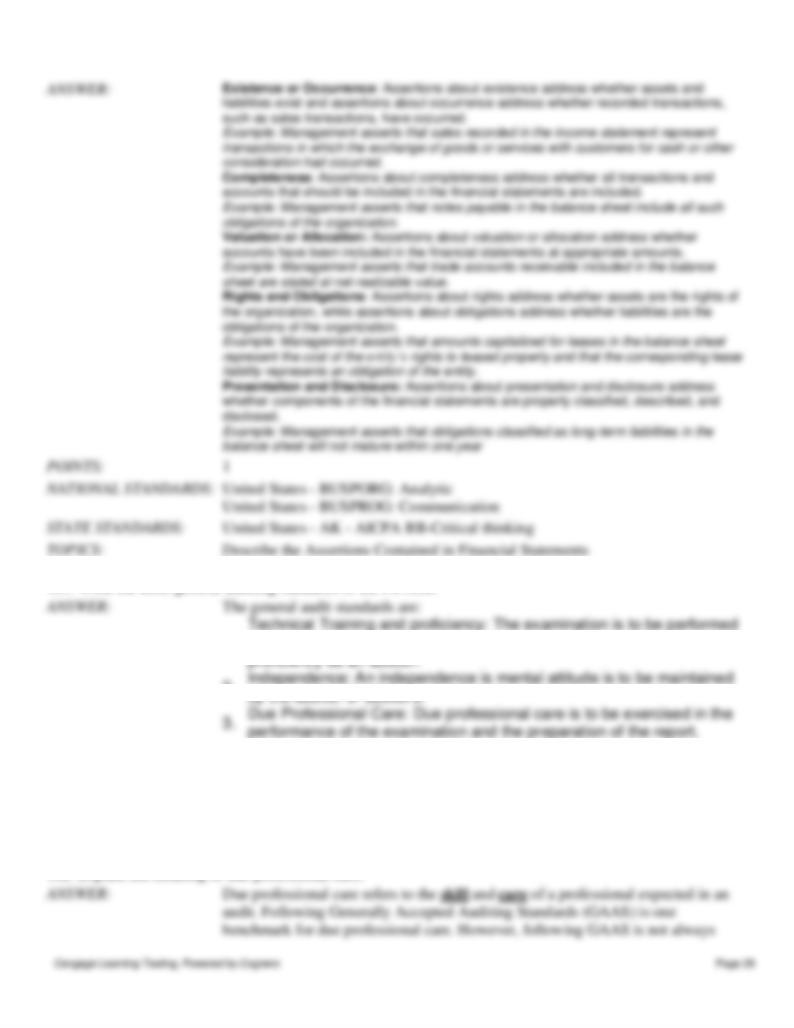
Chapter 5 - Professional Auditing Standards and the Audit Opinion Formulation Process
101. Write the three general auditing standards of the PCAOB.
1.
by a person or persons having adequate technical training and
2.
POINTS:
1
NATIONAL STANDARDS:
United States - BUSPORG: Analytic
United States - BUSPROG: Communication
STATE STANDARDS:
United States - AK - AICPA BB-Critical thinking
TOPICS:
Generally Accepted Auditing Standards and IAASB Principles
102. Explain the meaning of due professional care.
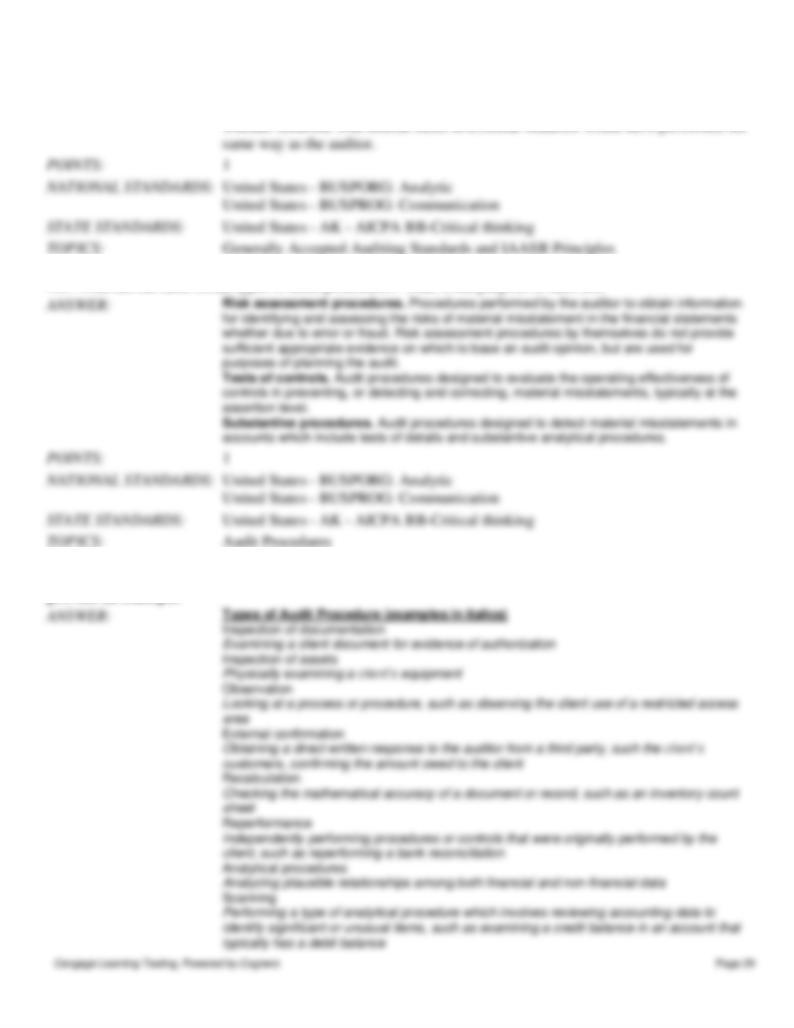
Chapter 5 - Professional Auditing Standards and the Audit Opinion Formulation Process
sufficient. If a reasonably prudent person would have done more, the professional
should do at least as much. Due professional care is also determined by evaluating
103. What are the three broad types of audit procedures? What is the purpose of each test?
104. There are nine specific actions an auditor can undertake to collect evidence. Identify each action and
provide an example.
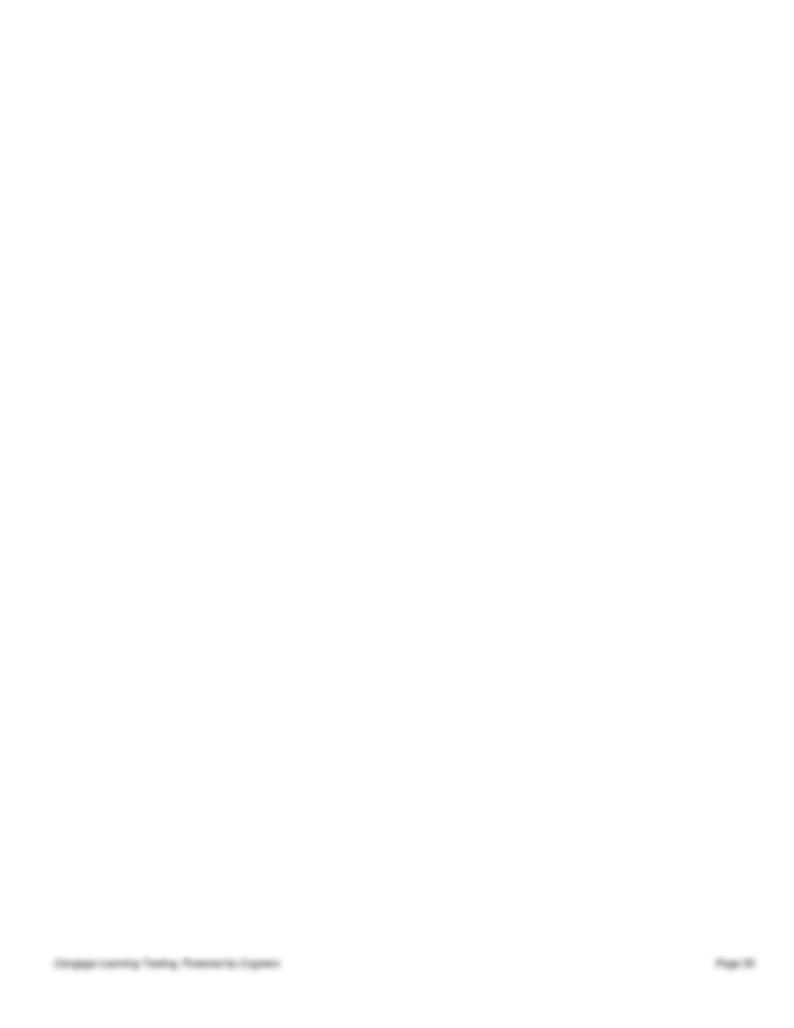
Chapter 5 - Professional Auditing Standards and the Audit Opinion Formulation Process
Inquiry
Seeking information of persons within or outside of the client organization, such as
communicating with the CFO or general counsel about changes in accounting policy
POINTS:
1
NATIONAL STANDARDS:
United States - BUSPORG: Analytic
United States - BUSPROG: Communication
STATE STANDARDS:
United States - AK - AICPA BB-Critical thinking
TOPICS:
Audit Procedures